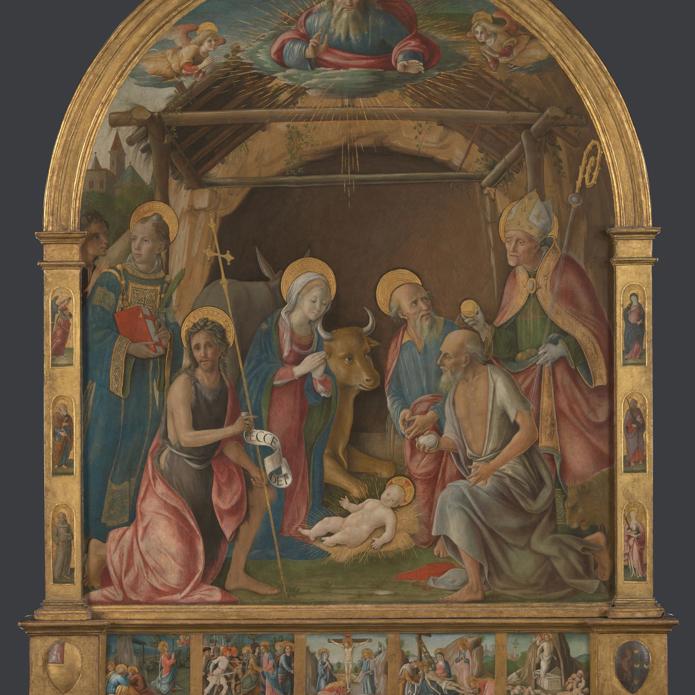Pietro Orioli, 'Scenes from the Passion: Predella', probably about 1485-95
About the work
Overview
The Passion of Christ (the episodes connected with his crucifixion and resurrection) is narrated in five scenes from left to right, starting with the Agony in the Garden of Gethsemane, moving through Christ’s betrayal and arrest to the Crucifixion, Deposition and Resurrection.
This is the predella (the lower panel) of an altarpiece painted for a small chapel in the castle of Cerreto Ciampoli near Siena in around 1495, the main panel of which is also in the National Gallery’s collection. The main panel shows the Nativity with the Annunciation to the Virgin at the top of the pilasters flanking it, so that the whole altarpiece acts as a summary of the most important events of Christ’s life, from his conception to resurrection. The coats of arms at either end are those of the commissioners, members of the Cerretani family.
Key facts
Details
- Full title
- Scenes from the Passion: Predella
- Artist
- Pietro Orioli
- Artist dates
- 1458 - 1496
- Part of the group
- The Nativity with Saints Altarpiece
- Date made
- probably about 1485-95
- Medium and support
- egg tempera on wood
- Dimensions
- 21.5 × 195.7 cm
- Acquisition credit
- Bought, 1901
- Inventory number
- NG1849.2
- Location
- Not on display
- Collection
- Main Collection
Provenance
Additional information
Text extracted from the ‘Provenance’ section of the catalogue entry in Martin Davies, ‘National Gallery Catalogues: The Earlier Italian Schools’, London 1986; for further information, see the full catalogue entry.
Exhibition history
-
2011Devotion by Design: Italian Altarpieces before 1500The National Gallery (London)6 July 2011 - 2 October 2011
Bibliography
-
1951Davies, Martin, National Gallery Catalogues: The Earlier Italian Schools, London 1951
-
1986Davies, Martin, National Gallery Catalogues: The Earlier Italian Schools, revised edn, London 1986
-
2001
C. Baker and T. Henry, The National Gallery: Complete Illustrated Catalogue, London 2001
About this record
If you know more about this painting or have spotted an error, please contact us. Please note that exhibition histories are listed from 2009 onwards. Bibliographies may not be complete; more comprehensive information is available in the National Gallery Library.
Images
About the group: The Nativity with Saints Altarpiece

Overview
The Christ Child lies naked and glowing in the centre of the main panel of this arched altarpiece, adored by his parents and four saints. More saints stand in the pilasters. Recent research has identified the original location of this altarpiece as a small chapel in the castle of Cerreto Ciampoli, around 13 km to the north of Siena.
In the late fifteenth century, the patronage of the chapel was in the hands of the Cerretani, who took their name from the castle; the coats of arms of a particular branch of the family appear on the predella (the part of an altarpiece below the main level). The saints included reflect the dedication of the chapel and the interests of the family.
For many years this painting was thought to be by Giacomo Pacchiarotto (who died in 1539/40), but is now attributed to Pietro Orioli, one of the most progressive of Sienese Renaissance painters.


